Stephen Hong Sohn's Blog, page 21
May 5, 2021
A Review of Julie Kagawa’s Iron Raven (Harlequin, 2021)
![[personal profile]](https://i.gr-assets.com/images/S/compressed.photo.goodreads.com/hostedimages/1491408111i/22407843.png) ljiang28
ljiang28
Written by Stephen Sohn
Edited by Lina Jiang
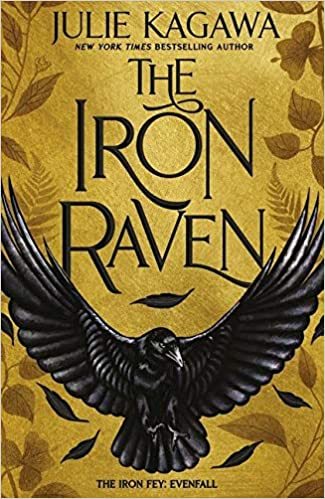
When Julie Kagawa’s Iron Raven (Harlequin, 2021) was first listed, I was totally stoked. For those in the know, this title is part of a longer series that began quite a while ago. There are at least eight books with a companion volume. I’ve obviously read them all, so I naturally wanted to get on this bandwagon, which focuses on the agent provocateur known as Robin Goodfellow. Here is the official marketing description: “Robin Goodfellow. Puck. Prankster, joker, raven, fool… King Oberon’s right-hand jester from A Midsummer Night’s Dream. The legends are many, but the truth will now be known, as Puck finally tells his own story and faces a threat from a time before Faery began. A threat that brings him face-to-face with a new enemy…himself. With the Iron Queen Meghan Chase and her prince consort, Puck’s longtime rival Ash, and allies old and new by his side, Puck begins a fantastical and dangerous adventure not to be missed or forgotten. Evenfall is coming, and with it a reckoning that even their combined powers and wits may not vanquish, as a shadow falls over the lands of Faery and the world slips into chaos.” This description is pretty vague and doesn’t even name the main characters that begin the journey that Puck embarks upon. There’s a kind of darkness that has invaded the land of the Faery, and it’s spreading in such a way that Puck and his allies must address if they are to preserve what is left of their magical lands. Puck’s main allies at the beginning of the novel are Meghan Chase’s son Keirran, who commands the fey known as the Forgotten, and Nyx, one of Keirran’s Forgotten henchpersons. Early on, Puck is “infected” by a beast of great darkness, and it causes him to grow horns. Any sense of morality that Puck had developed up to that point also seems to be eroding because of whatever he was wounded with. Keirran, Puck, and Nyx all travel to the iron realm, where they seek the support of Meghan and her husband Ash. As the first installment in what is likely a quartet, given the structure of the earlier texts, in the series, Kagawa has yet another entertaining, plot driven narrative for us to sink into. The greatest strength of Kagawa’s writing has always been the spirited use of first person narration. Kagawa’s Puck is certainly her most memorable character, so readers of YA will no doubt find this work compelling and will eagerly follow Puck into the future books.
Buy the Book Here
 comments
comments
March 24, 2021
A Review of Catherine Hernandez’s Crosshairs (Atria, 2020)
![[personal profile]](https://i.gr-assets.com/images/S/compressed.photo.goodreads.com/hostedimages/1491408111i/22407843.png) ljiang28
ljiang28
Written by Stephen Sohn
Edited by Lina Jiang

Catherine Hernandez’s Crosshairs (Atria, 2020) is the type of novel that takes on new meaning right now. Though it is a speculative fiction, set in some sort of alternate Canadian future in which people of minority backgrounds have become targeted and rounded up into labor camps, the novel strikes as far less unrealistic given the turbulent circumstances that have roiled the United States for at least the past four years. Let’s let the official marketing description get this review further situated: “Set in a terrifyingly familiar near-future, with massive floods leading to rampant homelessness and devastation, a government-sanctioned regime called The Boots seizes on the opportunity to round up communities of color, the disabled, and the LGBTQ+ into labor camps. In the shadows, a new hero emerges. After he loses his livelihood as a drag queen and the love of his life, Kay joins the resistance alongside Bahadur, a transmasculine refugee, and Firuzeh, a headstrong social worker. Guiding them in the use of weapons and close-quarters combat is Beck, a rogue army officer, who helps them plan an uprising at a major televised international event.” I appreciated this description because it focuses most on the BIPOC, queer and trans characters. Beck is the one character who is a white ally. The other major character is Liv, another white ally, who helps get Kay into hiding. Liv will also later help Firuzeh escape a labor camp in one of the most frightening sequences of the novel. Comparison’s to Atwood’s The Handmaid’s Tale are going to be unavoidable but Hernandez’s novel strikes far more acutely precisely because it’s not only women who are targeted but pretty much anyone that looks or acts or identifies as different. Hernandez gives these marginalized figures a name: the Others, who must find a way to resist and to fight against the new Canadian regime. The other comparison that is no doubt likely is that the Canadian Prime Minister strikes a shadow perhaps all too familiar for many Americans. It is this kind of parallel that makes Hernandez’s novel feel so visceral and more in line with a realist work than anyone might have at first imagined. Though the narrative itself can sometimes drag in terms of its plotting and momentum, the work is absolutely crystalline in terms of its polemical conceits, and I can certainly see this novel finding a big critical and popular audience since it is so timely.
Buy the Book Here
 comments
comments
A Review of Elizabeth Miki Brina’s Speak, Okinawa: A Memoir (Knopf, 2021)
![[personal profile]](https://i.gr-assets.com/images/S/compressed.photo.goodreads.com/hostedimages/1491408111i/22407843.png) ljiang28
ljiang28
Written by Stephen Sohn
Edited by Lina Jiang
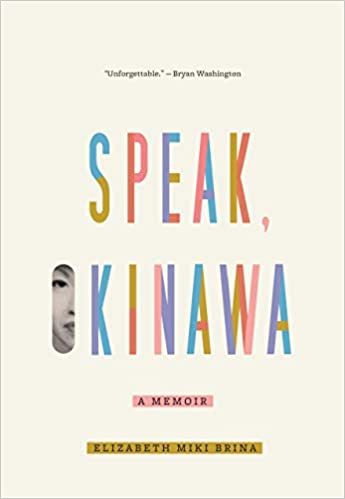
Absolutely floored by this elegantly crafted yet searing narrative! In Elizabeth Miki Brina’s Speak, Okinawa: A Memoir (Knopf, 2021), readers are in for quite the autobiographical journey. Let’s let the marketing description provide us with some tidbits: “A searing, deeply candid memoir about a young woman's journey to understanding her complicated parents—her mother an Okinawan war bride, her father a Vietnam veteran—and her own, fraught cultural heritage. Elizabeth's mother was working as a nightclub hostess on U.S.-occupied Okinawa when she met the American soldier who would become her husband. The language barrier and power imbalance that defined their early relationship followed them to the predominantly white, upstate New York suburb where they moved to raise their only daughter. There, Elizabeth grew up with the trappings of a typical American childhood and adolescence. Yet even though she felt almost no connection to her mother's distant home, she also felt out of place among her peers. Decades later, Elizabeth comes to recognize the shame and self-loathing that haunt both her and her mother, and attempts a form of reconciliation, not only to come to terms with the embattled dynamics of her family but also to reckon with the injustices that reverberate throughout the history of Okinawa and its people. Clear-eyed and profoundly humane, Speak, Okinawa is a startling accomplishment—a heartfelt exploration of identity, inheritance, forgiveness, and what it means to be an American.” The description provides us with perhaps the most crucial element to this memoir with the phrase “decades later.” It is the retrospective positionality which is Brina’s most sparkling tool. With the advantage of time and reflection, she certainly comes to understand much more not only about her personal life and her complicated inheritances but her larger position within a genealogy of war in the Asia-Pacific. Perhaps, one of the most arresting aspect of Brina’s work is a kind of collectivized narration, which explores the violent history of Okinawa. It is in this sense that Brina is working to reclaim part of her heritage, the part that she willfully tried to push away as she grew up. The description also employs the phrasing, “typical American childhood and adolescence,” but I would argue against that type of rendering. The narrative consistently reveals how abnormal that Brina felt her own childhood was, as a mixed race child. She intuitively understood how different her background made her, so she willfully distanced herself from anything related to Okinawa and her mother. In this way, the memoir enacts a form of reparative narration, something that reminds me of E.J. Koh’s similarly poignant work, The Magical Language of Others. The wistfulness that we see in this work and Koh’s is no doubt related to the retrospective positionality of the memoirist: if only she would have understood sooner what she has now come to know.
Buy the Book Here
 comments
comments
A Review of Jen Wang’s Stargazing (First Second, 2019)
![[personal profile]](https://i.gr-assets.com/images/S/compressed.photo.goodreads.com/hostedimages/1491408111i/22407843.png) ljiang28
ljiang28
Written by Stephen Sohn
Edited by Lina Jiang
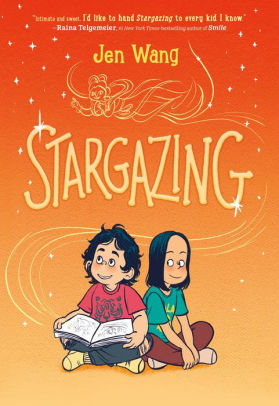
Jen Wang’s Stargazing (First Second, 2019) has been on my to-read list for some time. I picked it up when I needed a really great break from the work grind. I read it one night in one sitting; it took about an hour! In any case, let’s let the official marketing description give us some background: “Moon is everything Christine isn't. She’s confident, impulsive, artistic . . . and though they both grew up in the same Chinese-American suburb, Moon is somehow unlike anyone Christine has ever known. But after Moon moves in next door, these unlikely friends are soon best friends, sharing their favorite music videos and painting their toenails when Christine's strict parents aren't around. Moon even tells Christine her deepest secret: that she has visions, sometimes, of celestial beings who speak to her from the stars. Who reassure her that earth isn't where she really belongs. Moon's visions have an all-too-earthly root, however, and soon Christine's best friend is in the hospital, fighting for her life. Can Christine be the friend Moon needs, now, when the sky is falling?” This description actually gives away quite a lot. At its heart, the story is about friendship between two Chinese American girls of different class backgrounds. Moon comes into Christine’s life because Christine’s parents offer Moon’s mother (and Moon) a place to rent, which would be helpful because Moon’s mother finds herself in a bad financial situation. There are rumors that Moon is actually a bully, so it takes Christine a little bit of time to warm up to Moon, but eventually they become best friends. Over time, though, fissures start to emerge, with Christine wondering whether or not Moon is a good friend to have. Christine’s parents, in particular, make it clear that Moon is not the kind of girl that Christine should model her own life after, so Christine ends up putting in extra hours to study academic subjects. As she drifts away from Moon, Christine ends up become threatened by Moon’s new friendships. It is Moon’s medical condition which proves to push Christine to gain some new perspectives, allowing the graphic narrative to end on a very uplifting and satisfying note. As I’ve taught a number of graphic novels at this point, I can definitely see this work being adopted in many different types of courses. It certainly would appear to readers of all types and even of many distinct age groups. What I appreciate most about Wang’s illustrations are Wang’s choices concerning gender depictions, which are not confined to stereotypical cisgender representations. Certainly, Wang’s aesthetic approaches are rooted in a desire to complexify how we engage and understand the Chinese American experience. Highly recommended.
Buy the Book Here
 comments
comments
March 9, 2021
A Review of Trung Le Nguyen’s The Magic Fish (Random House Kids Graphic)
![[personal profile]](https://i.gr-assets.com/images/S/compressed.photo.goodreads.com/hostedimages/1491408111i/22407843.png) ljiang28
ljiang28
Written by Stephen Sohn
Edited by Lina Jiang

Trung Le Nguyen’s gorgeous debut The Magic Fish is one of those graphic narratives you wish you had grown up with. Its poignant and important narratives portray the complexities of queer Asian (North) American adolescence, and the book certainly would be a text you could read or teach or analyze alongside Rakesh Satyal’s Blue Boy, Shyam Selvadurai’s Funny Boy, and Alexander Chee’s Edinburgh. Let’s let B&N give us some more information via the official marketing blurb: Tiến loves his family and his friends…but Tiến has a secret he's been keeping from them, and it might change everything.
The Magic Fish is an amazing YA graphic novel that deals with the complexity of family, and it discusses how stories can bring us together. Real life isn't a fairytale. But Tiến still enjoys reading his favorite stories with his parents from the books he borrows from the local library. It's hard enough trying to communicate with your parents as a kid, but for Tiến, he doesn't even have the right words because his parents are struggling with their English. Is there a Vietnamese word for what he's going through? Is there a way to tell them he's gay? The Magic Fish is also a beautifully illustrated story by Trung Le Nguyen that follows a young boy as he tries to navigate life through fairytales, and it is also an instant classic that shows us how we are all connected. The Magic Fish tackles tough subjects in a way that accessible with readers of all ages, and teaches us that no matter what—we can all have our own happy endings. Nguyen’s book is particularly affecting because of the central relationship that emerges between an adolescent teenager and his mother. While Tiến struggles to find a way to tell his mother that he's queer, his mother is also embroiled in her own struggles: juggling a job while also realizing that her mother may be near death. The graphic novel takes a darker turn when Tiến’s mother must go immediately to Vietnam because her mother has died. Meanwhile, Tiến is unable to tell his mother about his feelings for members of the same sex. Fortunately, Tiến has some amazing middle school friends, the likes of which I wish I would have had at that same age, who embrace him with all of his differences.
Interspersed throughout the graphic novel are variations on the Cinderella fairytale; these three versions are of course a variation on Tiến’s own shifting sense of self. Can he find a way to embrace his multifaceted identity? As readers are well aware, not all versions of the fairytale end with the proverbial happy ending. In this sense, Nguyen’s work, while giving us a firmly resolved conclusion, nevertheless reminds us of the complicated trajectory that certainly awaits Tiến. No doubt a graphic novel I will teach in the future, and I’m sure others will jump on this bandwagon soon. This work is an absolutely stellar debut.
Buy the Book here:
https://www.amazon.com/Magic-Fish-Trung-Nguyen/dp/1984851594
 comments
comments
November 13, 2020
A Review of Silvia Moreno-Garcia's Mexican Gothic
![[personal profile]](https://i.gr-assets.com/images/S/compressed.photo.goodreads.com/hostedimages/1491408111i/22407843.png) jacobballew
jacobballew
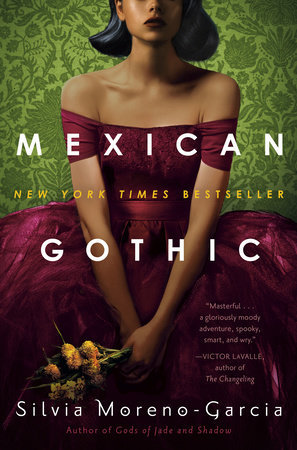
When reading, I often find myself bored and longing for something that will provide me a headstrong heroine or chivalrous hero, macabrely interesting villains, and drama akin to a telenovela, a Spanish prime-time soap. Thankfully Silvia Moreno-Garcia delivers all of this in a neat Gothic package. Here’s the official description from Penguin Random House:
“After receiving a frantic letter from her newly-wed cousin begging for someone to save her from a mysterious doom, Noemí Taboada heads to High Place, a distant house in the Mexican countryside. She’s not sure what she will find—her cousin’s husband, a handsome Englishman, is a stranger, and Noemí knows little about the region. Her only ally in this inhospitable abode is the family’s youngest son. Shy and gentle, he seems to want to help Noemí, but might also be hiding dark knowledge of his family’s past. For there are many secrets behind the walls of High Place. The family’s once colossal wealth and faded mining empire kept them from prying eyes, but as Noemí digs deeper she unearths stories of violence and madness.”
Mexican Gothic is an absolute page-turner from the very beginning. Every encounter Noemi has with her cousin’s husband’s family, the Doyles, is a fiery spectacle. The romantic tension between Noemi and the family’s youngest son, Francis, will have you blushing. Besides all of this dramatic flair, the horrors Noemi faces in High Place are both literal and figurative. We’ll start with the figurative, which is the legacy of colonial violence that High Place is built upon and has the town it inhabits, El Triunfo, in its grip. Right away the reader finds out that the Doyles have taken an extreme social Darwinism ideology in the way they regard others outside of the family, including Noemi and her cousin, Catalina. Without spoiling anything, I will say that this family goes to horrifying extremities to prove their superiority. Moreno-Garcia does a truly fantastic job in pulling the reader into the Gothic environment of High Place and she does not let you go. From the dark corridors of the mansion, the surrounding graveyard, the ghostly apparitions, and the gruesome visions, Moreno-Garcia is not subtle about anything. This is great because a lot of writers now tend to not go above and beyond and opt to keep things grounded, which proves to be boring if the novel is literally begging for spectacle to keep things interesting. I mentioned that there are ghosts and bloody visions, and yes, I am serious. These are not just for the sake of spooking the reader; each time Noemi sees the ghost of a past Doyle or finds herself in a gory, fleshy dream-world (yea, you read that correctly), important plot details and hidden secrets are revealed. I would love to read more from Moreno-Garcia, and if she ever tries writing within the horror genre, I will make sure to read it because she knows how to create terrifying imagery and situations. Towards the end of the novel, there was a scene reminiscent of the climax from Luca Guadagnino’s remake of Suspiria even. Mexican Gothic was released earlier this year in the summer and there’s already talk of a mini-series adaptation, so it’s obvious that this novel is hitting all the right spots. I’ll be sure to check out Moreno-Garcia’s other novels such as Certain Dark Things, which is a vampire novel set in Mexico City. I feel this has a place here at Asian American Literature Fans because it would be interesting to see a Filipino Gothic in the vein of what Moreno-Garcia has done since Mexican (or Latinx, in general) and Filipino cultures have been in the colonial crossroads of Spain.
Buy the book here:
https://www.amazon.com/dp/B07YWGXVTK/...
 comments
comments
November 12, 2020
A Review of RF Kuang's The Dragon Republic
![[personal profile]](https://i.gr-assets.com/images/S/compressed.photo.goodreads.com/hostedimages/1491408111i/22407843.png) jacobballew
jacobballew
![The Dragon Republic (The Poppy War Book 2) by [R. F. Kuang]](https://i.gr-assets.com/images/S/compressed.photo.goodreads.com/hostedimages/1605265977i/30372117.jpg)
ISBN: 9780062662637
Imprint: Harper Voyager
List Price: 26.99 USD
I read about 1/3 of R.F Kuang’s The Dragon Republic (Harper Voyager, 2019) before I set it down, then promptly forgot about it in the midst of a crazy academic year. I finally had the tail end of summer to read it! I very much enjoyed the action-packed first installment in this series (The Poppy War) and wanted to see how the narrative would continue. Here is the publicity description:
“Three times throughout its history, Nikan has fought for its survival in the bloody Poppy Wars. Though the third battle has just ended, shaman and warrior Rin cannot forget the atrocity she committed to save her people. Now she is on the run from her guilt, the opium addiction that holds her like a vice, and the murderous commands of the fiery Phoenix—the vengeful god who has blessed Rin with her fearsome power. Though she does not want to live, she refuses to die until she avenges the traitorous Empress who betrayed Rin’s homeland to its enemies. Her only hope is to join forces with the powerful Dragon Warlord, who plots to conquer Nikan, unseat the Empress, and create a new republic. But neither the Empress nor the Dragon Warlord are what they seem. The more Rin witnesses, the more she fears her love for Nikan will force her to use the Phoenix’s deadly power once more. Because there is nothing Rin won’t sacrifice to save her country . . . and exact her vengeance.”
I suppose I should provide my requisite spoiler warning here, as I sort of need to unveil plot details concerning the first and part of the second to set things up.
**Spoiler**
 comments
comments
A Review of Anna Wiener's Uncanny Valley
![[personal profile]](https://i.gr-assets.com/images/S/compressed.photo.goodreads.com/hostedimages/1491408111i/22407843.png) jacobballew
jacobballew
![Uncanny Valley: A Memoir by [Anna Wiener]](https://i.gr-assets.com/images/S/compressed.photo.goodreads.com/hostedimages/1605440925i/30380685.jpg)
Occasionally, we over at AALF move our curational boundary points a bit further. Such is the case with Anna Wiener’s Uncanny Valley (MCD, 2020), which I thought an interesting narrative to tackle given that its primarily set in Silicon Valley, a place I have lived and knew all too well. It’s certainly a place that does have a high concentration of Asian Americans! In any case, let’s let the official page over at MacMillan give us some context:
“The prescient, page-turning account of a journey in Silicon Valley: a defining memoir of our digital age. In her mid-twenties, at the height of tech industry idealism, Anna Wiener—stuck, broke, and looking for meaning in her work, like any good millennial--left a job in book publishing for the promise of the new digital economy. She moved from New York to San Francisco, where she landed at a big-data startup in the heart of the Silicon Valley bubble: a world of surreal extravagance, dubious success, and fresh-faced entrepreneurs hell-bent on domination, glory, and, of course, progress. Anna arrived amidst a massive cultural shift, as the tech industry rapidly transformed into a locus of wealth and power rivaling Wall Street. But amid the company ski vacations and in-office speakeasies, boyish camaraderie and ride-or-die corporate fealty, a new Silicon Valley began to emerge: one in far over its head, one that enriched itself at the expense of the idyllic future it claimed to be building. Part coming-of-age-story, part portrait of an already-bygone era, Anna Wiener’s memoir is a rare first-person glimpse into high-flying, reckless startup culture at a time of unchecked ambition, unregulated surveillance, wild fortune, and accelerating political power. With wit, candor, and heart, Anna deftly charts the tech industry’s shift from self-appointed world savior to democracy-endangering liability, alongside a personal narrative of aspiration, ambivalence, and disillusionment. Unsparing and incisive, Uncanny Valley is a cautionary tale, and a revelatory interrogation of a world reckoning with consequences its unwitting designers are only beginning to understand.”
This description is pretty spot-on. I don’t know if there’s that much I would add. I do think that one of the biggest thematic through lines of this text is the way in which Wiener must navigate complicated office politics, much of which revolves around the fact that her knowledge of code and general engineering principles is not necessarily the highest. Complicating factors further is the gender imbalances in the workplace, where Wiener is often one of the few women employed at any given startups. From a more autobiographical perspective, what this memoir puts into relief is the incredible disparities in wealth that I saw occurring in the Bay Area, especially as places like San Francisco saw skyrocketing rental prices and there were homeless individuals floundering in the streets of the Tenderloin. I found the Bay Area to be one of the most politically progressive places I have ever lived: there were multiple trash cans to sort organic refuse, recyclables (paper vs. plastic), green modes of transport, yet the memoir itself brings into relief some of the blinders that get raised in start-ups, especially the ways in which the corporation becomes a way of life, almost a faith and a spiritual calling. Wiener herself, as self-conscious as she is, sees this change in her own habits, struggles against it while acknowledging what can seem to be a hall of mirrors: code upon code, with promises of equity and IPOs on the horizon, untold wealth and all-knowing belief in the product, the application, the next new patch to solve all the bugs. Wiener seems to wonder about what the point of all of it is: was it just about making more money at the end of the day or was there a larger purpose to this kind of work? The rather meandering nature of the memoir seems to suggest no easy answer, but Wiener’s prose is sparkling in its reflective capacity. You’ll be glad she took some time away from the computer and the user interfaces to write something that could still be bought and sold in “meat spaces.”
Buy the Book Here:
https://us.macmillan.com/books/9780374719760
 comments
comments
A Review of Kiku Hughes's Displacement
![[personal profile]](https://i.gr-assets.com/images/S/compressed.photo.goodreads.com/hostedimages/1491408111i/22407843.png) jacobballew
jacobballew
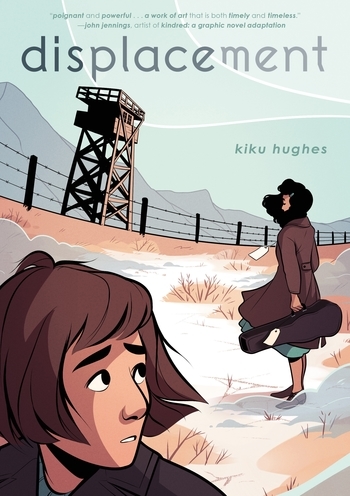
Kiku Hughes’s Displacement (First Second, 2020) is a graphic novel I had waited to read until I needed a true mental break. A former student of mine, Stephanie Otani-Sunamoto, had recommended it highly, so I knew it was going to be good. Let’s let MacMillan’s official marketing description get us started:
“A teenager is pulled back in time to witness her grandmother's experiences in World War II-era Japanese internment camps in Displacement, a historical graphic novel from Kiku Hughes. Kiku is on vacation in San Francisco when suddenly she finds herself displaced to the 1940s Japanese-American internment camp that her late grandmother, Ernestina, was forcibly relocated to during World War II. These displacements keep occurring until Kiku finds herself ‘stuck’ back in time. Living alongside her young grandmother and other Japanese-American citizens in internment camps, Kiku gets the education she never received in history class. She witnesses the lives of Japanese-Americans who were denied their civil liberties and suffered greatly, but managed to cultivate community and commit acts of resistance in order to survive. Kiku Hughes weaves a riveting, bittersweet tale that highlights the intergenerational impact and power of memory.”
The hook of the story is obviously the time traveling component. Early on, it only seems as though San Francsico’s fog seems to be a kind of trigger, but it becomes apparent that the fog isn’t really the issue. Eventually, Kiku is just stuck in the past, having to endure the internment alongside her grandmother (Ernestina Teranishi), someone who was a talented violinist but that Kiku did not know much about. For those of us who study Asian American history and representation, the general context of the internment camps is something we understand well, as it has been written about in numerous texts at this point. At the same time, Hughes adds a couple of distinct elements to this story. First, she adds to the visual field of internment representations, one that has been primarily shouldered by Mine Okubo. Second, Hughes does add a potentially speculative tool in her storytelling related to time travel. This latter element I found immensely compelling, and it’s no surprise that Hughes is a big fan of Octavia Butler’s Kindred, as there are obvious parallels. On the whole, the story is immensely engaging, and readers will be absolutely riveted by Kiku’s experience, her challenges, and her desires to make something of a traumatic past. At the same time, the concluding arc begins to suggest the time travel is more of a metaphor than anything literal. This development I found a little bit disappointing only insofar as the figurative dimension of time travel was already coded into what was occurring. There is a psychic reckoning with a past that has been only partially excavated thus far. To time travel becomes a figurative mode by which to work through the silencing of this event in one family. Besides my minor gripe—and don’t we readers always have our nitpicky gripes—the visuals were absolutely stunning, and the narrative is one I’ll be sure to adopt in future courses. Next semester, I will be teaching a graphic novel course, and you can bet your bottom dollar that I will be teaching Displacement!
Buy the Book Here:
https://us.macmillan.com/books/9781250193537
 comments
comments
A Review of Taran Matharu's The Challenger
![[personal profile]](https://i.gr-assets.com/images/S/compressed.photo.goodreads.com/hostedimages/1491408111i/22407843.png) jacobballew
jacobballew
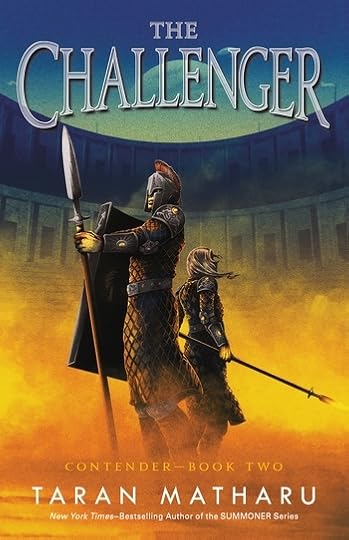
I had a great time reading Taran Matharu’s The Challenger (Feiwel & Friends, 2020), as it is the second installment in the Contender trilogy. The first (The Chosen) we already reviewed here at AALF, so here we are moving onto the second. Let’s let the official marketing blurb get us started.
“The stakes are higher than ever in The Challenger, the second book in the Contender YA trilogy by the New York Times bestselling author of the Summoner series, Taran Matharu. The first battle is over, but the Game is just beginning... Cade Carter and his friends have survived the qualifying round of the mysterious overlords' twisted games, decimated by the loss of so many of their comrades during the fight. But they have no time to mourn, for the next round of trials is about to begin. When the group discovers that their next foe will be even more ferocious than the last, Cade leads them on a quest out into their strange new world to find anything that might give them an edge. But what they find in the wilds could prove to be even more dangerous than the impending battle...The stakes are higher than ever in this thrilling sequel to The Chosen.”
So, there’s no way of getting around some spoilers, as I need to set up a little bit from the first installment, which leaves us with Cade and his merry band of contenders realizing that they have to get ready for a big battle. Once Cade is specifically selected from the group to fight an impressively evil-looking monster, they all agree that Cade is going to need some serious armor and some weaponry. Getting these resources requires that some of the group to leave their home, the keep, and to head out into the jungles. Cade heads out with a handful of others (including Amber, Grace, and Scott); things turn bad quickly, as they are captured. They are forced into a kind of tournament modeled on gladiators, and they must defeat all other teams, if they want to have a chance at freedom. You recall from the first installment that they have to survive this competition just so Cade can return in time to fight another monster. So, Matharu has set the stage for this second installment. What ends up being ingenious in a way is that this competition ends up getting Cade more fit and ready for the battle that will follow. Readers can rest assured that Cade is going to do well in this gladiator-style tournament precisely because there’s still a third book in the trilogy. But Matharu puts plenty of obstacles in Cade’s (and his team’s way). One particularly unsavory character from the first installment returns, and Matharu makes effective use of this antagonistic figure. Perhaps, the element that I find most enjoyable about Matharu’s series is his ability to weave in historical information at the right times. This world is one based upon individuals who have been taken from our reality under mysterious circumstances and deposited into a gamified reality, so you can imagine how many people or contexts that Matharu could use and input into the narrative. Whether it is a famous explorer, a pioneering aviator, a group of soldiers, or what have you, Matharu occasionally reminds us that these things that have gone away in our world may have been taken to this other world. Even entities that were thought to have gone extinct—like dinosaurs—find a way into this other place, where Cade and his allies must engage with if they are to survive. It remains to be seen what or who the big bad may be in this series. While Matharu has been planting some hints that there is an evil game overlord controlling Cade and his friends like chess pieces, my guess is that the reveal with be something else. But for now, we’ll have to wait and see, and wait for publication =).
Buy the Book Here:
https://us.macmillan.com/books/9781250138729
 comments
comments



